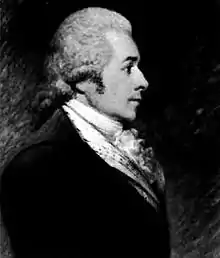John Samuel Sherburne
John Samuel Sherburne (1757 – August 2, 1830) was a United States Representative from New Hampshire and a United States District Judge of the United States District Court for the District of New Hampshire.
John Samuel Sherburne | |
|---|---|
 | |
| Judge of the United States District Court for the District of New Hampshire | |
| In office March 26, 1804 – August 2, 1830 | |
| Appointed by | Thomas Jefferson |
| Preceded by | John Pickering |
| Succeeded by | Matthew Harvey |
| Member of the U.S. House of Representatives from New Hampshire's at-large district | |
| In office March 4, 1793 – March 3, 1797 | |
| Preceded by | Samuel Livermore |
| Succeeded by | William Gordon |
| Personal details | |
| Born | John Samuel Sherburne 1757 Portsmouth, Province of New Hampshire, British America |
| Died | August 2, 1830 (aged 72–73) Portsmouth, New Hampshire, U.S. |
| Political party | Anti-Administration Democratic-Republican |
| Education | Harvard University Dartmouth College read law |
Education and career
Born in 1757, in Portsmouth, Province of New Hampshire, British America,[1] Sherburne attended Harvard University, graduated from Dartmouth College in 1776 and read law in 1776.[1] During the American Revolutionary War he served in the Continental Army as a brigade staff major.[1] He entered private practice in Portsmouth, New Hampshire from 1776 to 1789, and from 1797 to 1801.[1] He was United States Attorney for the District of New Hampshire from 1789 to 1793, and from 1801 to 1804.[1] He was a member of the New Hampshire House of Representatives from 1790 to circa 1793, and in 1801.[1]
Congressional service
Sherburne was elected as an Anti-Administration candidate from New Hampshire's at-large congressional district to the United States House of Representatives of the 3rd United States Congress and reelected as a Democratic-Republican to the 4th United States Congress, serving from March 4, 1793, to March 3, 1797.[2]
Federal judicial service
Sherburne was nominated by President Thomas Jefferson on March 22, 1804, to a seat on the United States District Court for the District of New Hampshire vacated by Judge John Pickering.[3][1] He was confirmed by the United States Senate on March 24, 1804, and received his commission on March 26, 1804.[1] His service terminated on August 2, 1830, due to his death in Portsmouth.[1]
Involvement in impeachment, conviction and removal of Pickering
Pickering was the first federal official to be removed from office through impeachment on March 12, 1804.[4] Sherburne, who as a witness for the prosecution managers had aided the case for Pickering's removal even though the latter was insane and did not knowingly commit "high crimes and misdemeanors" on the bench,[5] himself became insane and was for all intents and purposes removed from the bench in 1826, though he continued to receive his salary until his 1830 death.[6]
References
- John Samuel Sherburne at the Biographical Directory of Federal Judges, a public domain publication of the Federal Judicial Center.
- United States Congress. "John Samuel Sherburne (id: S000339)". Biographical Directory of the United States Congress.
- Lynn W. Turner, "The Impeachment of John Pickering," The American Historical Review, Vol. 54, No. 3 (Apr. 1949), p. 505.
- Lynn W. Turner, "The Impeachment of John Pickering," The American Historical Review, Vol. 54, No. 3 (Apr. 1949), p. 504.
- Lynn W. Turner, "The Impeachment of John Pickering," The American Historical Review, Vol. 54, No. 3 (Apr. 1949), p. 501.
- Lynn W. Turner, "The Impeachment of John Pickering," The American Historical Review, Vol. 54, No. 3 (Apr. 1949), p. 506.
Sources
- United States Congress. "John Samuel Sherburne (id: S000339)". Biographical Directory of the United States Congress.
- John Samuel Sherburne at the Biographical Directory of Federal Judges, a public domain publication of the Federal Judicial Center.
| U.S. House of Representatives | ||
|---|---|---|
| Preceded by Samuel Livermore |
United States Representative from New Hampshire's at-large congressional district 1793–1797 |
Succeeded by William Gordon |
| Legal offices | ||
| Preceded by John Pickering |
Judge of the United States District Court for the District of New Hampshire 1804–1830 |
Succeeded by Matthew Harvey |